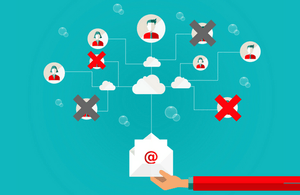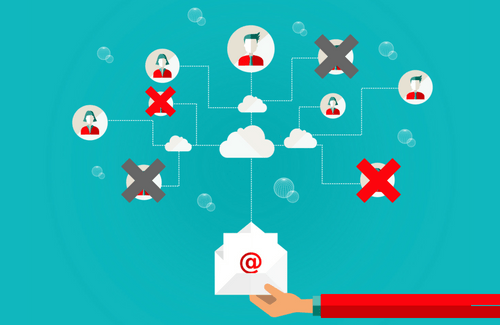 I’m going to break some bad news to you, so make sure you’re sitting down.
I’m going to break some bad news to you, so make sure you’re sitting down.
Not all of your marketing emails make it to their end recipients.
Unfortunately there are no absolutes in email deliverability. Whether you’re sending bulk email marketing materials or a direct message to a customer, sometimes emails hide in spam folders or simply don’t turn up when they’re supposed to. However, there are a number of ways you can help tip the odds in your favour, and wouldn’t you know it, they’re all excellent ways of creating a standout email experience for your subscribers too.
But before we get to the tips, we need to look at how sending reputation works…
How Do Spam Filters Decide What’s Spam?
We’re all aware of junk email and the annoyance it can cause. For a good while now, internet service providers (ISPs) and email service providers (ESPs, such as Outlook, Gmail, and email hosting companies) have been tasked with keeping the realm of email as safe as possible for all users.
Therefore, email sending reputation was born. Domains (which are the “@whatever.com” part of an address), and IP addresses (a unique address that identifies internet-connected devices and servers) are assigned a sending reputation score, giving an indication of whether a sender is genuine, or if they’re a potential spamming risk. Most ESPs also use authentication practices to ensure senders are the real deal.
Emails sent by those with a poor sending score can have a harder time reaching recipients. As an email traverses the web towards its intended goal, it can be stopped in its tracks by spam filters, and some are more draconian than others.
There are a variety of factors that go into deciding where each sender falls on the reputation scale, but on the whole those who practice ethical and conscientious email marketing practices will stay in good standing. Rather than listing the reasoning behind a sender’s reputation (or lack thereof), let’s take a look at a few email marketing best practices and how they play into maintaining a rosy rating.
How to Improve Your Email Deliverability
Follow an Ethical Opt-In Process
Thanks to the GDPR (and it’s quieter but been-there-all-along cousin PECR) individuals have ultimate power and autonomy over how companies use their personal data. Therefore, opt-ins to receive marketing email should be sought consensually, with a clear and auditable action from the subscriber in order to sign up. Adding email addresses to lists without permission (including using purchased lists) has become the ultimate no-no, but it won’t just cause you legal problems.
In order to try and police things, many email providers and ISPs set up email addresses as “spam traps”: unmanned email addresses that look genuine, but aren’t set up to receive any bulk mail. So if they do start to receive marketing mail, it’s obvious that the sender is just looking online for addresses and isn’t seeking opt-ins first. Data from spam traps can inform internet-wide blacklists, so getting caught out can cause you untold deliverability issues.
Be Clear, Honest, and Useful
When you’re putting together the copy for your subscriber opt-in pages, take a long, hard look at the types of mailouts you send and make sure that’s accurately reflected when people sign up. If you promise one thing sent twice a month, but end up sending something totally different every single day, recipients may be left feeling disgruntled. Also, focus on providing genuine value and usefulness in your mailouts (maybe through blog updates, highlights from social media, or industry advice) rather than focusing on the hard sell. Nobody likes being sold to after all, and overly salesy and bothersome emails may see people clicking on the unsubscribe link or “report spam” button.
When you click “Mark as Spam” in your email software, it may not simply chuck that mail in the spam folder. It can send signals to the mail server, indicating that this sender should be treated as a potential spammer. There are so many different email servers online, and some pay more heed to these reports than others. “Mark as Spam” is more than just a button, it can potentially cause you serious damage!
Unsubbing Should be Easy
All bulk emails should come with an option to easily unsubscribe from future email sends, and most bulk email packages include unsubscribe functions as standard. Preferably unsubscription should be a 1-click process; if there’s no easy way to unsubscribe from your mail, people can easily resort to marking the email as spam – you want to avoid this at all costs.
If you have multiple lists or different types of marketing emails, you may want to consider a “preference centre” approach. This is where subscribers can tailor the type of emails they want to receive – for example stating that they want to keep receiving blog updates, but that they withdraw permission for you to send them sales offers. This way they don’t have to completely unsubscribe from all communications so you can stay on their radar, albeit in a reduced way.
Email is a Two-Way Street
All marketers want to open up a dialogue with prospects, so ideally you want people to simply click reply on any email to lodge an enquiry. So, set up your bulk mailing software to send from a real, manned email address – it all paints a picture of being reachable and authentic.
When you’re setting up your email addresses and servers for marketing purposes, make sure that everything is configured to send and receive without a hitch. Continued email server errors can paint you as an unreliable source. Similarly, if the emails you send are poorly formatted, with badly coded HTML and poor quality text and images, this can also result in you being potentially flagged as a spammer.
Be Aware of Your Formatting Choices
The formatting within your emails can also rouse suspicion from both spam filters and human recipients. Using ALL CAPS, $ub$t1tut3d ch4r4ct3r$, or lots of exclamation marks can get spam filters standing to attention – especially when used in the subject line. But that doesn’t mean you have carte blanche for the body of the email; red flags can be raised by including all of the email’s body text in an image, pointing to broken links, or using poorly coded HTML. Keep it simple when it comes to formatting – focus your attention on creating compelling and attractive copy to grab people’s attention rather than gaudy design.
Sidenote: Also familiarise yourself with the numerous spam trigger words and phrases that can easily get you automatically branded as spam. Corny lines like “Buy Now”, “Free”, and “Apply today” can all cause spam filters to give you mad side-eye. This fairly exhaustive list should give you a good idea of terms to avoid, especially when putting together your subject lines.
Maintain a Consistent Volume of Sent Marketing Email
Think about how many marketing emails you send. If you’re in the habit of sending three marketing emails a month, spam filters may raise an e-brow at a sudden spikes such as multiple bulk mailouts in one day. Perhaps send out a survey to ask your subscribers how often they’d like to receive emails from you and stick to that schedule.
Spring Clean Your Lists All Year Round
Always keep your lists up to date by removing any addresses that continually bounce (meaning those that fire back errors such as “no such user” or “mailbox full”), and even bidding farewell to those who haven’t opened any of your mails for a while. Continuing to send emails to broken addresses is absolutely terrible for IP reputation, and emailing those who show no interest over and over again can cause spam filters can take notice. Needless to say, it pays to keep an eye on how your lists are performing.
In Conclusion
If you take anything away from this article, let it be this: there is far more to email marketing than simply creating emails and sending them out. You need to ensure that opt-ins and opt-outs are simple yet deliberate; focus on providing value in your emails and welcome the opportunity to start a conversation; and make sure that your lists are kept clean, tidy, and consensual.
Keep ’em peeled for our forthcoming article about email marketing best practices to give your readers the best possible subscription experience!
[bctt tweet=”Don’t assume all your emails are received. Find out why not, and how to help ensure they do” username=”yellbusiness”]
So dear reader, are you making any mistakes that might affect your sending reputation? We won’t tell – honest! Or are there any reputational errors that we’ve missed off here? Let us know down in the comments!






